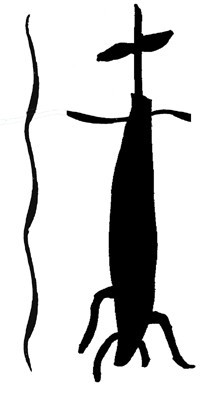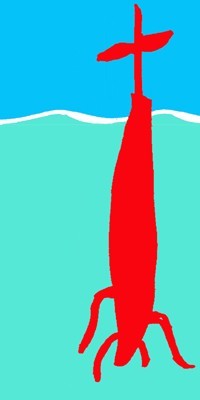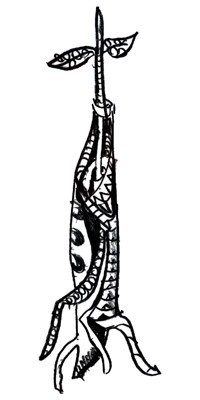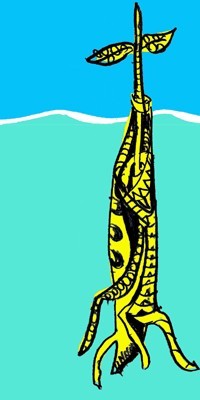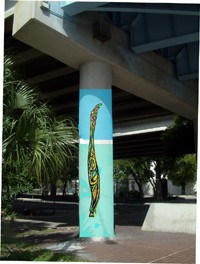Home » 2004 » Miami Mangrove Forest » Miami Mangrove Forest: About
At its core, Miami Mangrove Forest functions as a metaphoric reforestation of downtown Miami. Initiated in 2004, Xavier Cortada’s expansive public mural underneath the underpasses of I-95 explores the evolving dichotomy between the natural and built environments. Mangroves, an essential aspect of much of Cortada’s work, were chosen for their native heritage to the South Florida area. Mangrove forests were the dominant landscape of the state from the time of the first European settlers, subject matter previously portrayed in Cortada’s Florida Mangrove painting from 2003. This allows for the work to be viewed as decidedly site-specific, there being a contextual resonance to the inclusion of mangroves in a project based in Miami.
Fully grown, mangroves serve a multitude of purposes, from providing habitats for a variety of marine and avian life to protecting coastal areas from storm surges. The communal focus of Miami Mangrove Forest is further emphasized through the utility of the mangrove, it being a plant that literally protects and shelters communities of a variety of species. However, throughout the entirety of Miami Mangrove Forest, the depiction of mangroves is that of seedlings instead of fully-grown trees. This was conceptual in intent, the seedlings a representation of the individual citizens of Miami setting their roots in the young city. This allows for a presentation that functions temporally, an implication of a city growing year by year, generation by generation, all while the painted mangroves exist in a state of permanent infancy.
Fifteen years after Miami Mangrove Forest, Cortada led the creation of Pinecrest Mangrove Forest, a mural that depicts the fully-grown mangrove forest the seedlings from the original mural would eventually become. However, Pinecrest Mangrove Forest functions more than just a metaphoric reforestation of the local area, but as a prompt for literal reforestation, a conceptual and practical evolution from its predecessor. This is accomplished through its resonance with Cortada’s Plan(t) project, an ambitious effort to plan for the future through the act of planting mangroves throughout Miami.
Hands On Miami 2004
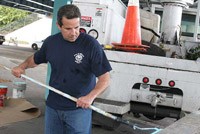
During Hands on Miami Day, on November 6, 2004, more than 3,000 volunteers participated in painting, planting trees and cleaning up the neighborhoods of Greater Miami.
The City of Miami asked Hands on Miami to have its volunteers paint the blighted areas underneath the I-95 and I-395; that is, the Interstate’s underside as it crosses through Miami’s streets (Biscayne Boulevardand 2nd Ave, and 8th Street). The city also asked for help in beautifying the flyover at 17th Avenue in Allapattah.
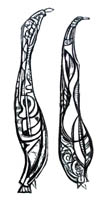
Hands on Miami asked Xavier Cortada to design artwork for all the underpasses and columns in a way that would make the entire project a cohesive and uniform art piece. As he did for his murals in the Florida Capitol, Cortada chose mangroves as the centerpiece of the work.
Using stencils on the columns and walls they paint, hundreds of volunteers reproduced Cortada’s designs and transformed the entire area into Miami’s Mangrove Forest.
Using 8 foot by 4 foot stencils designed by the Miami artist Xavier Cortada and Hands on Miami Volunteers painted three mangrove seedlings on each column at underpasses in three Miami neighborhoods. Each column’s three seedlings were painted with one of 18 predetermined colors, the areas surrounding it appeared as sea and sky. To see studies of seedlings scroll down or click on: magenta, red,orange, yellow, green and violet.
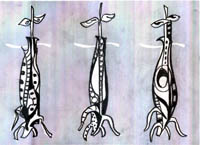
Students will then return to the site with black paint and reproduce images uniquely designed by Xavier Cortada for each and every seedling.
With the conclusion of Phase 1 the project spread across three communities (Allapattah, Downtown Miami, and Little Havana) and have a sea of 279 unique mangrove seedlings, each “setting its roots” in our community.
